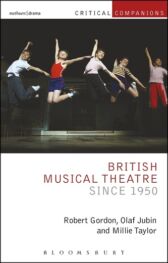Synopsis
British Musical Theatre since 1950
Robert Gordon & Olaf Jubin & Millie Taylor
Published by Methuen
This critical introduction to post-war British musical theatre is the first book to discuss its post-war developments from the perspective of British as opposed to American popular culture
The genre is situated within the historical context of post-war British society in order to explore the range of forms through which significant sociocultural moments are represented.
Introductory chapters analyse the way British musicals have responded to social change, the forms of popular theatre and music from which they have developed and their originality in elaborating new narrative strategies since the seventies
A key feature of the book is its close readings of twelve key works, from Salad Days (1954) and Oliver! (1960) to global smash hits such as Les Misérables (1985) and The Phantom of the Opera (1986) and beyond, including the latest critical and box-office success Matilda (2011)
Also analysed are British favourites (Blood Brothers, 1983), cult shows (The Rocky Horror Show, 1975) and musicals with a pre-existing fan-base, such as Mamma Mia (1999)
TABLE OF CONTENTS
List of Illustrations
Introduction
PART ONE: Musicals and Social Change
1.1 British Theatre and Society after the Second World War
1.2 Innovation and Nostalgia: Camp in the Post-War British Musical
Case Study 1: Salad Days
1.3 Rock and Roll and the Theatre Revolution
1.4 The Play with Music: Political Theatre and Working-Class Culture
Case Study 2: Blood Brothers
1.5 The Impact of Oliver!
1.6 After Jesus Christ Superstar: Globalization and Cultural Specificity
Case Study 3: Billy Elliot
1.7 Global and Local: The Family Musical
Case Study 4: Matilda The Musical
PART TWO: British Popular Culture and Musical Theatre
2.1 Nostalgia in Character and Dramatic Form
Case Study 5: Oh What a Lovely War!
2.2 Reflecting Multiculturalism
Case Study 6: Bombay Dreams
2.3 Changing Signification in Popular Music
Case Study 7: Oliver!
Case Study 8: The Rocky Horror Show
Conclusion to Part Two
PART THREE:: Narrative and Story-Telling in the British Musical since 1970
Preamble
Introduction
3.1 Concept Recordings: When What You See is What You Have Heard
Case Study 9: Jesus Christ Superstar
3.2 Sung-Through Shows: When the Spoken Word is Shunned
3.3 Stage Adaptations of Novels: When the Written Word Becomes Theatrical Action
Case Study 10: Les Misérables
Case Study 11: The Phantom of the Opera
3.4 Original Stories: When the Content is Unknown
3.5 Jukebox Musicals: When You Know All the Songs
Case Study 12: Mamma Mia!
3.6 Stage Adaptation of Films: When the Cinematic Becomes the Theatrical
Conclusion
Timeline
Notes
Selective Bibliography
Discography
Filmography
Index
Makes a great gift!
 $27.99
$27.99